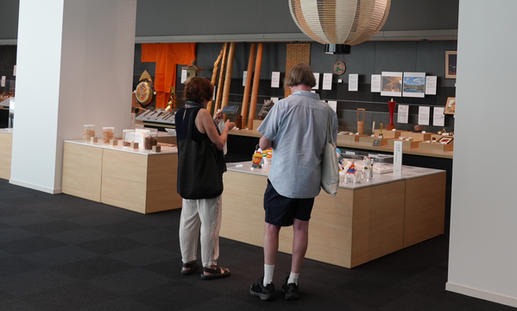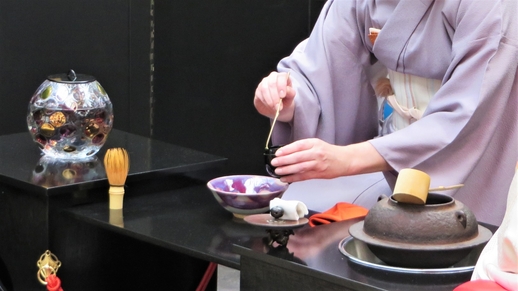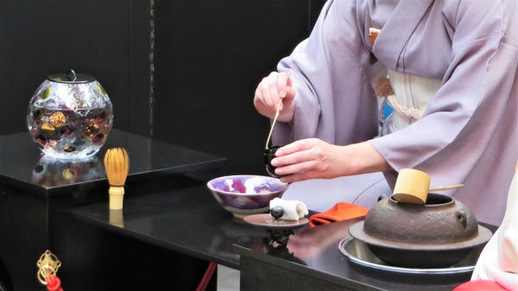2024.10.31
伝検通信(メルマガ)週刊メールマガジン「伝検通信」 第30号
週刊メールマガジン「伝検通信」第30号をお届けします。
今号のトップ記事は、京都で行われる伝統工芸の大規模コンペティション(作品コンテスト)の話題です。
「クイズで肩慣らし」は前回クイズの答え・解説と、茶道・和菓子・日本茶分野からの出題です。
11月から実施する2級および3級の第1回伝検の受験申し込みを受け付けています。公式テキスト、2級受験者向けオンライン講座の販売もスタートしています。ぜひお申し込みください。
伝検申込サイト https://denken-test.jp/
目次
・ 伝統文化・産業を未来へ 京都市で大規模コンペ
・ 「クイズで肩慣らし」第30回(茶道・和菓子・日本茶)=「点前」
・ 伝検協会だより
伝統文化・産業を未来へ 京都市で大規模コンペ

京都伝統産業ミュージアムの展示コーナー
日本の「千年の都」として愛される京都。その伝統から紡がれた美と技の世界を紹介する京都伝統産業ミュージアム(京都市左京区)が、日本古来の文化・産業を未来へ伝えることを目的に、新たなコンペティションを開催する。同市で大規模なコンペティションが開かれるのは初めてといい、八田誠治館長 は「全国から若手の職人を幅広く募り、伝統産業をさらに盛り上げていきたい」と意気込んでいる。
◇伝統素材・技法を活用
新コンペ「TRADITION FOR TOMORROW」では、伝統工芸の手法を生かしつつ、現在の生活様式やニーズに応える作品を募集。全国の芸術系大学、専門学校の学生らを対象とした学生部門と、京都ゆかりの伝統工芸作家、職人ら向けの一般部門を設定した。応募締め切りは11月末。来年2月から同ミュージアムで展示・審査が行われ、グランプリには賞金100万円が贈られる。
八田館長は日本の伝統産業に関して「和の文化、特に『お茶』や『お花』を中心とした日常の中の文化が衰退しているように感じる」と指摘。その上で「伝統的な素材・技法は、保存するだけでなく、それを活用してこそ未来へ継承することができる」とコンペの意義を説明する。
◇担い手育成、外国人も視野
ミュージアムでは、西陣織や京友禅などの染織品から京焼、京漆器といった工芸品まで、伝統産業とその背景を紹介している。伝統的な素材・技法を現代につなげるのが狙いで、コンペに先駆けて、展示コーナー「Tradition Meets Today」を新設、新たな作品づくりに挑戦する若手職人や工房をPRしている。10月には京焼、清水焼や京漆器の職人、作家によるコーヒーカップやマグカップなどを集めた展示・販売会を開いた。
ミュージアムを運営する京都産業振興センターは、京都市のほか、京都商工会議所、地元の地方銀行などが出資する半官半民企業。山本達夫社長は「行政は補助金を出すことができるが、限界がある。事業会社であれば、買い付けも販売も手掛けられる」と強みを生かして伝統産業支援を続ける考え。また、将来の担い手の確保について「京都は伝統産業に興味を持つ若者が集まりやすいので、こうした人材を育てていく。日本のモノづくりに興味を持ってくれる外国人も多く、彼らが突破口になるかもしれない」と語った。
京都伝統産業ミュージアム
「クイズで肩慣らし」第30回(茶道・和菓子・日本茶)=「点前」
~伝検公式テキスト(好評発売中)の分野ごとに出題します~

茶道で抹茶を点(た)てる一連の所作、点前(てまえ)
第30回
問題:茶の湯では、10月も半ばをすぎると「名残(なごり)」という時季を迎え、秋には茶会が多く開催されます。最近よく見かける、テーブルといすを使って行うお茶の点前(てまえ)を何というでしょうか。
(答えと解説は次号で)

六芒星(ろくぼうせい)」の形に見えることから、 魔よけの力があるとされる文様
【前回の問題と答え・解説】
問題:竹かごなどを編んだ編目を意匠化したもので、 江戸時代には浴衣などに用いられていた、 邪気をはらう魔よけの意味を持つ文様を何というでしょうか。
答え:籠目(かごめ)文様
解説:籠目文様は、日本の伝統的な幾何学文様の一つで、その名は竹などで編まれた籠の網目に由来しています。特徴的な六角形の網目が、「六芒星(ろくぼうせい)」の形に見えることから邪気を払い魔よけの力があるとされ、昔の日本の民家には玄関先に竹籠がお守りとして掛けられていました。また、籠という文字は龍に竹をかぶせていることから、籠の中には龍の神秘的な力が宿るともされていました。
伝検協会だより
▼日本の優れた工芸品などを紹介する特別展「日本の芸術的な職人技」がフランス・パリで10月17~20日に開かれました。同展は、仏高級ブランド「ルイ・ヴィトン」を傘下に持つLVMH(モエ・ヘネシー・ルイ・ヴィトン)が2015年に設立した「LVMHメティエダール」の主催。弊会の賛助会員である三菱UFJフィナンシャル・グループ(MUFG)が、開化堂(本店・京都市)の茶筒や、中川木工芸比良工房(滋賀県大津市)主宰の中川周士さんが制作した木製おけの展示で協力しました。日本の伝統文化に関する情報を世界に発信するため、弊会も会員の皆さまと連携して知恵を絞っていきたいと考えています。
編集後記
本通信も気が付けば30回。毎週さまざまな記事や検定試験に向けた肩慣らしのクイズをお届けしてきました。試験開始まで残り1カ月を切りました。伝検サイト「公式教材・参考書」のタブから関連サイトも紹介されています。本通信の過去記事やクイズと併せて、ぜひご覧ください。
【English version】
Weekly e-mail magazine “DENKEN TSUSHIN” No. 30
We are pleased to present the 30th issue of our weekly e-mail magazine “Denken Tsushin.
The top article in this issue is about a large-scale competition (art contest) for traditional crafts in Kyoto.
In the “Quiz to familiarize yourself” section, you will find answers and explanations to the previous quiz and questions from the fields of tea ceremony, wagashi (Japanese confectionery), and Japanese tea.
We are now accepting applications for the first DENKEN test for Level 2 and Level 3, which will be held in November. The official textbook and online course for Level 2 examinees are also available for purchase. Please apply now.
DENKEN application site: https: //denken-test.jp/examination/
Table of Contents
・Kyoto City to Hold Large-Scale Competition to Promote Traditional Culture and Industry for the Future
・Quiz to familiarize your shoulders: Vol. 30 (Tea ceremony, Japanese sweets, Japanese tea) = “DESSEN
・From the Denken Kyokai
Traditional Culture and Industry for the Future Large-Scale Competition in Kyoto City

Exhibition corner at the Kyoto Museum of Traditional Industries
Kyoto is loved as Japan's “City of a Thousand Years. The Kyoto Museum of Traditional Industries (Sakyo-ku, Kyoto), which introduces the world of beauty and craftsmanship spun from the traditions of Kyoto, will hold a new competition with the aim of passing on the ancient culture and industries of Japan to the future. This is the first time a large-scale competition will be held in the city, and museum director Seiji Hatta is enthusiastic, saying, “We would like to invite young craftspeople from all over the country to participate and further promote the traditional industry.
◇Utilizing traditional materials and techniques
The new competition, “TRADITION FOR TOMORROW,” calls for works that respond to current lifestyles and needs while utilizing traditional craft techniques. There are two divisions: a student division for students of art universities and vocational schools nationwide, and a general division for artists and craftspeople of traditional crafts associated with Kyoto. The deadline for applications is the end of November. The Grand Prix winner will receive a prize of 1 million yen.
Director Hatta pointed out that Japanese traditional industries “seem to be in decline in terms of Japanese culture, especially in everyday life with a focus on ‘tea’ and 'flower arrangement. He then explained the significance of the competition, saying, “Traditional materials and techniques can be passed on to the future not only by preserving them, but also by utilizing them.
◇Fostering bearers, with an eye on foreigners
The museum introduces traditional industries and their backgrounds, from dyed textiles such as Nishijin brocade and Kyoto Yuzen to crafts such as Kyo-yaki and Kyo lacquerware. In October, the museum will hold an exhibition and sale of coffee cups and mugs made by craftsmen and artists of Kyo-yaki, Kiyomizu-yaki, and Kyo lacquerware. In October, the museum held an exhibition and sale of coffee cups and mugs made by craftsmen and artists of Kyoto-yaki, Kiyomizu-yaki, and Kyoto lacquerware.
The Kyoto Industrial Promotion Center, which operates the museum, is a semi-private company funded by Kyoto City, the Kyoto Chamber of Commerce and Industry, and local banks. President Tatsuo Yamamoto said, “The government can provide subsidies, but there are limits. As an operating company, we can handle both purchasing and sales. Regarding the securing of future leaders, Mr. Yamamoto said, “Kyoto easily attracts young people interested in traditional industries, so we will continue to nurture such people. There are many foreigners who are interested in Japanese manufacturing, and they may be the key to a breakthrough.
Kyoto Museum of Traditional Industries
Quiz to familiarize yourself with Japanese tea ceremony, Japanese sweets, and Japanese tea ceremony
~Questions will be given for each field in the official DENKEN textbook (now on sale).

The sequence of actions involved in serving matcha in the tea ceremony
Question: In chanoyu, the season of “nagori” (remnants of the past) begins after the middle of October, and many tea ceremonies are held in the fall. What is the name of the tea ceremony commonly seen these days, where the tea is served at a table and on chairs?
(See the next issue for the answer and explanation.)

The pattern is believed to have the power to ward off evil because it looks like a “six-pointed star.
Previous Question and Answer / Explanation
Question: What is the name of the design of a woven bamboo basket, which was used in yukata (summer kimonos) in the Edo period (1603-1868) to ward off evil spirits?
Answer: Kagome pattern
Description: Kagome pattern is one of the traditional geometric patterns of Japan, and its name comes from the meshes of baskets woven of bamboo and other materials. The characteristic hexagonal meshes look like a “six-pointed star” and are believed to have the power to ward off evil and ward off evil spirits, and bamboo baskets were hung at the entrance of Japanese houses in the past as a talisman. It was also believed that the mystical power of the dragon resided in the basket, since the character for basket is a dragon covered with a bamboo.
From Denken Kyokai
A special exhibition “Japanese Artistic Craftsmanship” was held in Paris, France, from October 17 to 20 to introduce outstanding Japanese crafts and other artifacts. The exhibition was organized by LVMH Metiers d'Art, established in 2015 by LVMH (Moet Hennessy Louis Vuitton), which owns the French luxury brand Louis Vuitton. Mitsubishi UFJ Financial Group (MUFG), a supporting member of the Association, cooperated in the exhibition of tea caddies from Kaikado (head office, Kyoto City) and wooden toke made by Shuji Nakagawa, the leader of Nakagawa Wood Crafts Hira Kobo (Otsu City, Shiga Prefecture). The Association would like to cooperate with its members to share information on Japanese traditional culture with the rest of the world.
editorial postscript
This newsletter has now reached its 30th issue. Each week we have provided various articles and quizzes to familiarize you with the exam. There is less than a month left until the exam starts. You can also find related sites on the DENKEN website under the “Official Teaching Materials and Reference Books” tab. Please take a look at them along with the past articles and quizzes in this newsletter.
カテゴリー: 伝検通信(メルマガ)





